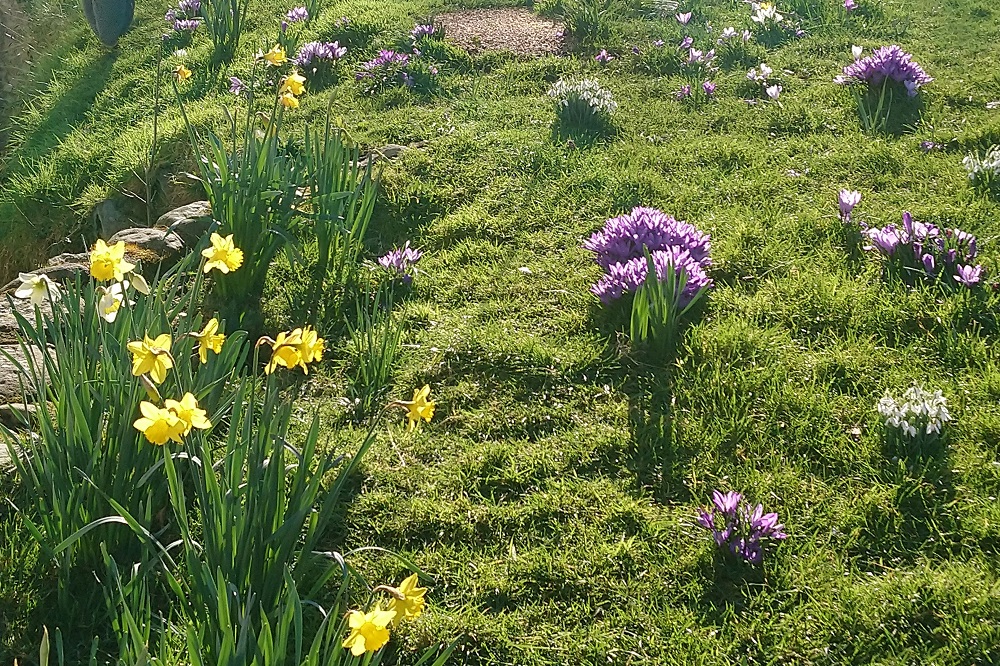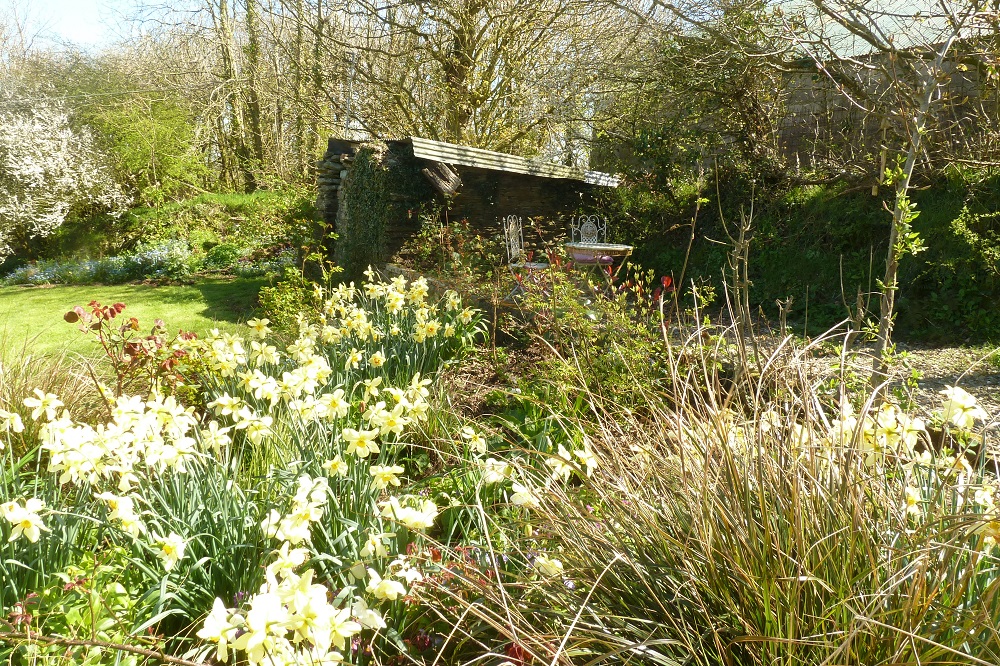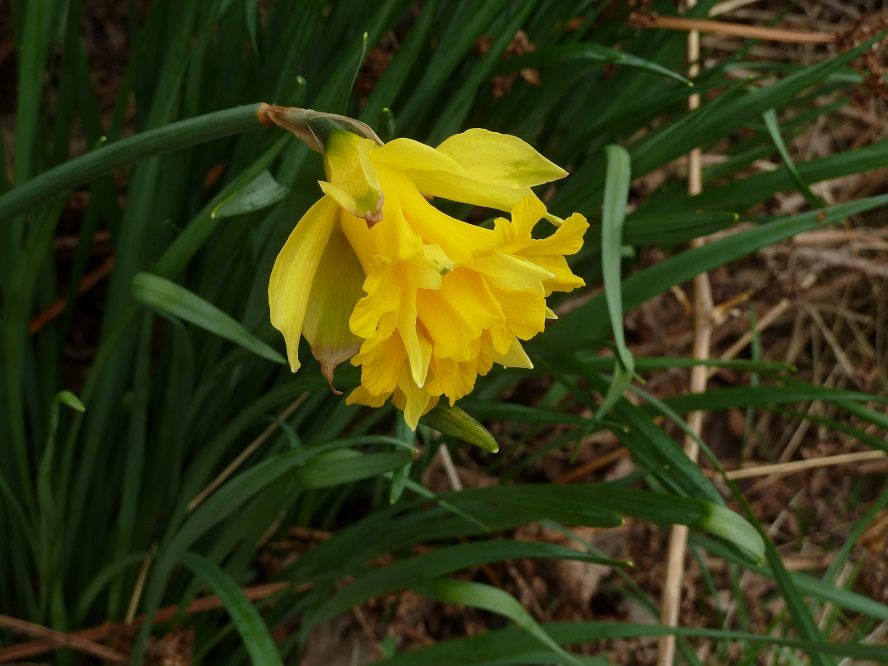Cynefin – A Sense of Place: A Suffragette Spring

Gaynor Funnell
Today, Spring is the colour purple. Purple, white and green. From my limited viewpoint out of the kitchen window, ribbons of violet, lavender, mauve, lilac, indigo and white crocus wander between a sward of fresh green.
Their flowers arch from a cluster of thin, straplike leaves, which have a chalk-line drawn down the centre of them.
A finger-touch of sun is all that’s needed for the tulip-shaped flowers to open like sea anemones, their golden stamens trembling in the March breeze.
One has caught a fat bumblebee. It has a tawny, chenille bottom and climbs lazily over the petals with sherbet-dusted legs, as if just woken from a soporific slumber.
The carpet of amethyst starfish-like Crocus tommasinianus that hide under the cherry tree have been replaced by their more voluptuous cousins which prefer to exhibit themselves under a full sun.
‘Ruby Giant’ spreads indiscriminately. Its name is somewhat misleading, as it is neither red nor large. It stands four inches tall, and its colour is a rich, deep violet, fading gently towards its egg-yolk centre.
Originally from southern Europe, it was introduced to Britain in 1936. It drifts amongst the paler colour of Crocus chrysanthus ‘Blue Pearl’. Their goblet shaped flowers aren’t blue, but a beautiful, iridescent, washed lavender, with tiny purple brushstrokes pointing towards the stem.
The petals have a silvery sheen and gleam in the early spring light. It has a faint, sweet perfume, although you have to lie down to appreciate it.
Smudge of smoke
Not as prolific as the above, another snow crocus is the elegant ‘Snow Bunting’. It’s a pure, gleaming, bright white with a smudge-of-smoke feathering on its outer petals, a throat of butter-yellow, and it too has a delicate scent.
‘Snow Bunting’ was introduced here in 1914 and was named after the bird Plectrophenax nivalis, which lives in Iceland and Greenland.
This white winged sparrow-like bird flies down to the sea from its breeding ground in the mountains during November to February, the same time the crocus is in flower.
Here, the blooms burst open amongst the dark green, flat, matt leaves of the soon-to-be-open daisies and the newness of the grass, which needs a temperature of over six degrees to initiate growth, knitted with the asparagus-spears of daffodil leaves.

New beginnings
The name Crocus originated from the Greek, ‘Krokos’ meaning saffron, although the species that produce the most expensive spice in the world flower in the autumn, and are a rich, golden yellow.
It can take 75,000 flowers to produce one pound of the spice.
Spring flowering crocus thrive on a rocky soil in thin grassland, and their leaves die down entirely after flowering.
In Greek mythology, Crocus was a noble youth, who killed himself when he was forbidden to marry the girl he loved. Knowing this, it’s strange that in the language of flowers, the crocus stands for cheerfulness and new beginnings.
In America, it’s often known as the ‘light bulb’ flower as it brightens up the world after the darkness of winter.
Green, White, Violet
Purple, green and white – the colours representing the suffragette movement in England. Dress and attire became an important part of the campaign. In 1908, Emmeline Pethick-Lawrence, co-editor of the Votes for Women magazine, and member of the Woman’s Social and Political Union (WSPU) wrote ‘Be guided by the colours in your choice of dress…we have seven hundred banners in purple, white and green.’
The colours had been chosen symbolically – purple stood for loyalty, freedom and dignity, white for purity and green for hope, and if you replace the purple with violet, the initials of Green, White, Violet, stand for Give Women Votes.
Members were encouraged to wear these colours as ‘a duty and a privilege’ and to dress smartly and fashionably to detract from their negative stereotypical image drawn by the cartoonists of the day.
Sylvia Pankhurst, a founder member of the WSPU, designed many of the items worn, and members often chose jewellery to correspond with the colours, the semi-precious stones used including amethyst, pearls and peridot.
This ‘branding’ now common today, was one of the first of its kind to promote a movement, the colours becoming instantly recognisable as those of the suffragettes.
In America, gold replaced green, the colour representing the colour of light and life. In 1867, the Kansas suffragists adopted the state flower, the sunflower, as a symbol of their campaign, ‘…the torch that guides our purpose, pure and unswerving.’
They lost their battle to win the vote at that time, but the colour gold was adopted by the national movement. Gold pins, sashes and yellow roses become recognisable symbols of their cause.
Maine suffragists chose the daffodil as their symbolic flower. This smaller flower was easier to carry or wear and could be ‘forced’ to bloom earlier or later, so could be picked for a longer time.

Withstand the wind
Further up the lane, where the grass becomes wiry and tough, the first of the daffodils are piercing their way through the early spring soil. These are Tenby daffodils, reputed to be the original St. David’s day daffodil.
Matt-glaucous and squat, which helps them withstand the wind that blows across from the sea or down from the Preseli mountains, they have cups and petals of the same shade of bright gold.
In my overgrown border, other varieties I’ve planted will soon start to make an appearance. Not for me, the blowsy, heavy-headed, frilled giants that abound in suburban gardens, the ones that snap with the hint of a puff of wind.
I love the old, historic dancing varieties, ones that have stories to tell or have names that sing. My favourite is ‘Bath’s flame’, which was introduced before the first world war and is the colour of a freshly cut pineapple, the petticoat of the cup dipped in burnt copper-red.
Its head dips slightly and the elongated petals have a slight twist. It sways and bends with the breeze, as does its neighbour, ‘White Lady’, an even older variety, and popular as a cut flower between the wars.
She has an elegant, drooping neck, and tissue paper-fine petals of white, which tilt as if shielding her face from the sun, her sherbet-lemon drop centre carrying a faint scent of hyacinth and vanilla.

Trail of tears
The oldest of the bulbs, and one seen naturalised in many gardens nearby is the unusual Van Sion daffodil, or Telamonius Plenus.
It has a double trumpet cup but can morph into a mop head, similar to the mane of a lion, reverting back the year after if it feels it wants to.
The colour and shagginess alters according to the weather – if it’s cold, the canary-bright yellow of the flower becomes streaked and splashed with lime-green. It’s a strong grower here and naturalises easily.
It was first reported flowering in the garden of a Vincent Sion in London, in 1620, and by the 1700’s had spread to America, taken by British immigrants who settled in Kentucky, Tennessee and Virginia.
Apparently, you can still find the plants in the original gardens of long-gone houses. Van Sion was also a favourite of the Native Americans who were forced to travel along the so-called the ‘Trail of Tears’ to Oklahoma.
And, once freed, African Americans transported the bulbs northwards to Mississippi and beyond – the Appalachian hills becoming covered with gold and green trumpets.
Gaynor Funnell is the winner of the Nigel Jenkins award for 2022. We are delighted to be publishing a series about Penbanc over the coming months, with support from the H’mm Foundation.
You can read the serialisation so far here
Support our Nation today
For the price of a cup of coffee a month you can help us create an independent, not-for-profit, national news service for the people of Wales, by the people of Wales.





My neighbour has daffodils already in flower. In previous years they have even flowered in November.